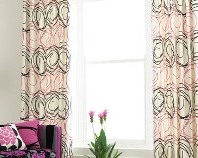The Eyes Have It
 October 6, 2007
October 6, 2007 Irwin Weiner -- I clearly remember my art projects from nursery school. My favorite was a living room interior I created with paint and crushed eggshells. It had a gold chandelier and red tied-back draperies.
 Let's ignore completely the fact that I was drawing interiors back in nursery school while other kids were scribbling things like this picture. Here's what I'm really wondering about: I don’t know where I could have seen those types of interior details.
Let's ignore completely the fact that I was drawing interiors back in nursery school while other kids were scribbling things like this picture. Here's what I'm really wondering about: I don’t know where I could have seen those types of interior details.
The home I grew up in had more of an I Love Lucy interior, something mid-century modern. I couldn’t have seen this particular interior on TV either. Television didn’t arrive in South Africa until I was a teenager. Perhaps my design inspiration was from an ad in a bus shelter or somewhere in a movie magazine that I might have paged through. The fact is, I was already looking at interiors and judging what I thought was beautiful and what was not. Even at such a young age, I had -- albeit in a simple form –- taste. And I was looking around at interiors and visually processing my surroundings.
As a teenager in the 1970s, I hoped to purchase a Villeroy & Boch china pattern with the faux marble surround. I thought it absolute perfection. I saw this as a set of china I could enjoy for rest of my days. Thankfully, my tastes have changed. Again, I was processing things around me, I was looking and thinking, and informing my sense of style every step of the way.
Like the overdone chicken and egg analogy, which comes first: style taste or trend? Did I like the fake marble in that china pattern because it was fashionable, or was my attraction a deep expression of my innermost aesthetic desire? Perhaps it was a combination of the two, but no matter.
Frankly, my decorating dears, I don’t give a damn. My love-hate relationship with that set of dishes reflects one thing only: my aesthetic education. Shortly before he died, the prolific artist and colorist Paul Klee declared that he finally understood color. And I’m now only beginning to feel the same about interior design, some 21 years into my career.
 A decade ago, I visited Palladio’s famous Villa Foscari ("La Malcontenta") outside of Venice. More recently, I visited Mies van der Rohe’s Tugendhat House in Brno, Czech Republic. After years of looking, seeing, and experiencing interior design, I found myself in spaces that I consider to be absolute perfection. I was equally, and vastly, moved by both structures. These were my Design Temples, both awe inspiring and possibly life changing.
A decade ago, I visited Palladio’s famous Villa Foscari ("La Malcontenta") outside of Venice. More recently, I visited Mies van der Rohe’s Tugendhat House in Brno, Czech Republic. After years of looking, seeing, and experiencing interior design, I found myself in spaces that I consider to be absolute perfection. I was equally, and vastly, moved by both structures. These were my Design Temples, both awe inspiring and possibly life changing.
Why life changing? I think it's because in both spaces, I felt humbled to the point of giving up design, totally and completely throwing in the towel. The mastery of these design achievements made me feel that my design education hadn’t even begun. Palladio and Mies were undoubtably geniuses. Since my visits to their temples, I have come to terms that I might never create such enduring structures or design interiors that will last forever.
But life goes on, and my decorating Grail awaits. On the one hand, I am humbled to the point of humiliation by experiencing great design. On the other hand, I am inspired by the height of the design barre. It’s limitless what great design can create. I am climbing.
And I am looking at everything. Design2Share has been a great experience in allowing me to look at the fine work of my fellow interior designers. Most of them, the unpublished ones and the ones you see in the finest shelter magazines, has achieved something sublime that I've been able to look at, process, and come away better for the experience.
But here comes a note of caution: Look at everything, but don't label everything fabulous. Train yourself to Learn to Look and then to Be Discerning. Please watch our first Design2Share video on Getting a Great Look to help you start your approach to a great visual design education.
A philosopher once said that one could either be a strainer, a sieve, or a sponge. The sponge absorbs all that person is exposed to. The strainer retains the lees, the dregs. But the sieve retains the gold.
I wanna be a sieve, I wanna be a sieve! And I want you all to be sieves, too.
Years ago, the goal of many interior design projects was to purchase magnificent pieces of art or furniture that were so incredible, one’s heirs fought over them for generations. The Frick collection is an excellent example of a wealthy art patron's blindingly amazing interior. Some of the Paris salons at the beginning of the 20th century were parallel achievements.
With tremendous changes in technology, politics, and even climate, we’ve come to terms with adapting to change much more frequently than anyone from our parent’s generation. Change acceleration has also hit the design world. In the last dozen years or so, we’ve seen collective style tastes range from traditional to 1940s to 1950s to 1970s to contemporary to Baroque, and so on.
Decorating is fast becoming an aerobic exercise.
Learning to Look will help you develop your sense of style and good taste while style trends are changing so rapidly.
-
Experiencing great interiors first hand is the best way to visually educate yourself on the fundamentals of great design.
-
The Internet is a lesser experience, but it's a good substitute if beautiful homes and interiors are not accessible. Look up great designers, great architecture, and great interiors.
-
My recommendation for the next-best-thing to real interiors is the wonderful world of high-end shelter magazines, also known as "decorator porn." Magazines like World of Interiors, Architectural Digest, Elle Décor, and the English edition of House & Garden are the loves of my life. Look through them, look for what thrills you, and sieve away the rest.
Constant looking and evaluating is what design education should entail. It is an enjoyable and sometimes humbling lifetime pursuit. I hope you enjoy every beautiful step in the path.
Share your favorite inspirational buildings or interiors with me. Thank you for your comments . . . .
Photo credits: In Vivo, CISA A.Palladio













Reader Comments